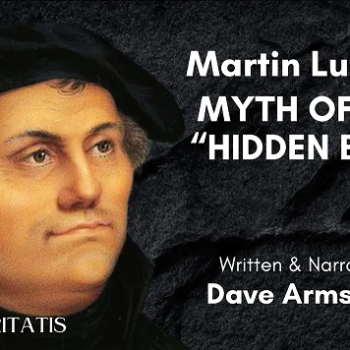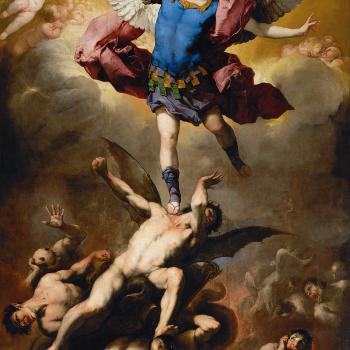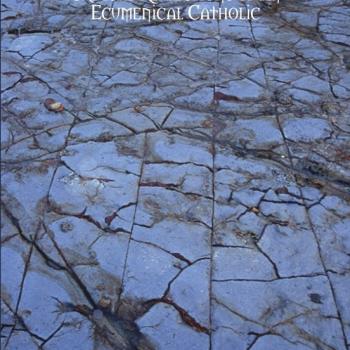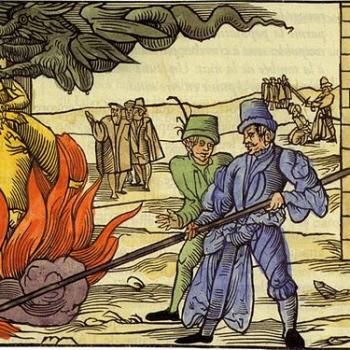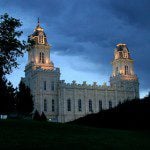vs. Jason Engwer (Emphasis on the Canon of the Bible & Church Infallibility)
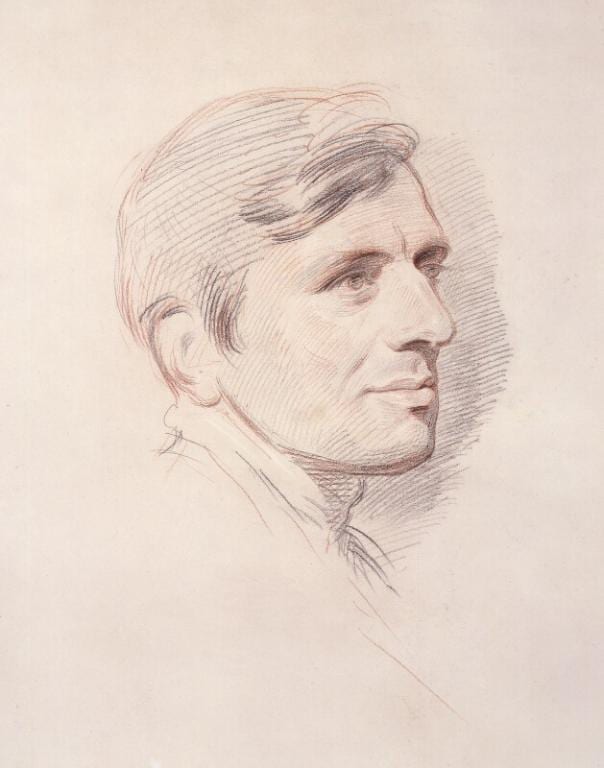
[originally posted on my blog on 1-15-10]
***
I will be replying to anti-Catholic Protestant Jason Engwer’s article, “The Canon And Church Infallibility” (9-18-08). His words will be in blue.
***
*
Some of my comments are unclear without the surrounding context of the e-mail discussion. In addition to the distinction between infallibility and inerrancy, I noted that other distinctions could be made.
And of course one must know the precise Latin and Greek terms used by the fathers. But this is primarily an example of Jason’s notorious “can’t see the forest for the trees” obfuscation. Is there really all that much of a difference, and does it have any significant effect on this discussion? No. There certainly is not much difference in English. Merriam-Webster Online gives the following definitions:
Inerrancy: “exemption from error.”
Infallible: “incapable of error.”
This ain’t exactly the difference between the Atlantic and Pacific Oceans. Free Online Dictionary is almost identical:
Inerrancy: “exemption from error.”
Infallibility: “the quality of never making an error.”
Fr. John A. Hardon’s Modern Catholic Dictionary is also instructive:
Inerrancy: The absence of error. Commonly applied to the Bible as the revealed word of God. (Etym. Latin in-, not + errare, to err: inerrans, not wandering.)
Infallibility: Freedom from error . . . (Etym. Latin in-, not + fallibilis; from fallere, to deceive: infallibilis, not able to deceive, or err.)
And the terms “infallible” and “inerrant” are used in different ways in different contexts. I wouldn’t just distinguish between what one church father might say as compared to the comments of another father.
Muddying the waters is fine: let Jason play that game if he must; but now how about some actual examples, so we can examine something concrete, rather than dealing with vague abstractions and by no means irrefutable generalizations? In the rare instances where Jason gives these, invariably his “case” collapses or loses much of its alleged force, as we have seen throughout this critique, and as I have shown again and again in past dialogues with him.
I would also distinguish between how different concepts can be in mind at different times within the writings of a single father. A reference to the reliability of a church or bishop, for example, isn’t necessarily meant to be a reference to infallibility.
Nor is it necessary for this to be the case, to defend legitimate Catholic development of doctrine, as I have explained several times in the previous installments. But it sounds impressive, so Jason keeps using this polemical tactic.
A church or other entity that’s correct in its teachings can be considered inerrant in that sense without an accompanying belief that error isn’t possible in the future.
The additional element is what we call indefectibility. It is a root assumption of apostolic succession: that the truth will never be lost; it will always be preserved.
A church that’s doctrinally correct today could be doctrinally incorrect fifty years from now.
That is usually the case in Protestantism, yes; while Catholic doctrine remains the same. So Jason’s analysis surely applies to Protestants on a large scale.
Or a church that’s expected to always be correct on some issues could err on other issues. Many people, including Protestants, believe that a church has always existed since the time of the apostles and will always exist until Christ’s return.
Good for them. Kindergarten Christianity . . .
Since particular characteristics are required for an entity to qualify as that church, the church that always exists would have to always have those characteristics. For example, somebody could argue that beliefs such as monotheism, the Messiahship of Jesus, and the resurrection are essential Christian doctrines, that such doctrines must be present in order for the church to be present, and that therefore there always is a church that holds such beliefs. We could argue that such a view involves an infallible church, but I don’t think that’s what most people have in mind in disputes over church infallibility.
Since those things are held in common by all Christians, they do not by themselves resolve the problem of which is the one true Church. Jews and Muslims and Arians and, e.g., Native American religionists, however, are monotheists, too.
But if you read the article by A.N.S. Lane that I linked, you’ll see some examples of the wide variety of views of the church and tradition that existed in the patristic era and later centuries.
Lane’s article (he is an evangelical Protestant) quite surprisingly makes the same fundamental mistake about the nature and origin of a fairly explicit conception of development of doctrine, that I have noted as present in pseudo-scholars and hyper-critics of Newmanian development, such as William Webster and James White. It is assumed that the notion of doctrinal development was hatched almost out of the blue by Cardinal Newman in the 1840s (and some — like pseudo-patristic-“scholar” David T. King — have ignorantly equated it with the heretical and condemned modernist “evolution of dogma”). Hence, Lane writes on pp. 47-48, about “the unfolding view” that he had earlier equated with Newmanian development:
But this does not mean that there is no novelty in the unfolding view. From Augustine to Bossuet it was assumed that what the contemporary church held was Catholic because it had always been held by the church. The contemporary teaching of the church was a source because explicit apostolic tradition was to be found there. The modern view is very different. The contemporary teaching of the church is normative even although it is only implicit in Scripture and earlier tradition.
He completely overlooks the crucial contribution of St. Vincent of Lerins (d. c. 450): whose teaching contains the basic category distinctions of Newman’s theory of development. It’s not as if this is some unknown thing among historians of doctrine (which is why it is quite remarkable that a scholar of the stature of Lane overlooked it). Cardinal Newman himself refers to him in his Essay on Development. For example:
Section 1. First Note of a Genuine Development—Preservation of Type
This is readily suggested by the analogy of physical growth, which is such that the parts and proportions of the developed form, however altered, correspond to those which belong to its rudiments. The adult animal has the same make, as it had on its birth; young birds do not grow into fishes, nor does the child degenerate into the brute, wild or domestic, of which he is by inheritance lord. Vincentius of Lerins adopts this illustration in distinct reference to Christian doctrine. “Let the soul’s religion,” he says, “imitate the law of the body, which, as years go on, developes indeed and opens out its due proportions, and yet remains identically what it was. Small are a baby’s limbs, a youth’s are larger, yet they are the same.” (from Part II, chapter 5: “Genuine Developments Contrasted With Corruptions”)
Newman wrote in a latter dated 19 July 1862:
As to development of doctrine and action in the Church I should hold to Vincentius’s account of it, who compares it to bodily growth, “ut nihil novum postea proferatur in senibus, quod non in pueris jam antea latitaverit,” . . . (from The Life of John Henry Cardinal Newman, by Wilfred Ward, 1912, Vol. I, Appendix to Chapter 18)
Philip Schaff also understood that both St. Augustine and St. Vincent espoused an explicit notion of doctrinal development:
Augustine, the ablest and the most devout of the fathers, . . . justly subordinates these councils to the Holy Scriptures, which are the highest and the perfect rule of faith, and supposes that the decrees of a council may be, not indeed set aside and repealed, yet enlarged and completed by, the deeper research of a later day. They embody, for the general need, the results already duly prepared by preceding theological controversies, and give the consciousness of the church, on the subject in question, the clearest and most precise expression possible at the time. But this consciousness itself is subject to development. While the Holy Scriptures present the truth unequivocally and infallibly, and allow no room for doubt, the judgment of bishops may be corrected and enriched with new truths from the word of God, by the wiser judgment of other bishops; the judgment of the provincial council by that of a general; and the views of one general council by those of a later. . . . Augustine, therefore, manifestly acknowledges a gradual advancement of the church doctrine, which reaches its corresponding expression from time to time through the general councils; but a progress within the truth, without positive error. For in a certain sense, as against heretics, he made the authority of Holy Scripture dependent on the authority of the catholic church, in his famous dictum against the Manichaean heretics: “I would not believe the gospel, did not the authority of the catholic church compel me.” In like manner Vincentius Lerinensis teaches, that the church doctrine passes indeed through various stages of growth in knowledge, and becomes more and more clearly defined in opposition to ever-rising errors, but can never become altered or dismembered. (History of the Christian Church, Vol. II, ch. 5, § 65. The Synodical System. The Ecumenical Councils)
Schaff even states that Augustine’s and Vincent’s formulation of development were “substantially the same” as Newman’s:
Within the limits of the Jewish theocracy and Catholic Christianity Augustin admits the idea of historical development or a gradual progress from a lower to higher grades of knowledge, yet always in harmony with Catholic truth. He would not allow revolutions and radical changes or different types of Christianity. “The best thinking” (says Dr. Flint, in his Philosophy of History in Europe, I. 40), “at once the most judicious and liberal, among those who are called the Christian fathers, on the subject of the progress of Christianity as an organization and system, is that of St. Augustin, as elaborated and applied by Vincent of Lerins in his ‘Commonitorium,’ where we find substantially the same conception of the development of the Church and Christian doctrine, which, within the present century, De Maistre has made celebrated in France, Mohler in Germany, and Newman in England.” (Editor’s Preface to City of God, 38-volume set of the Church Fathers, 10 December 1886)
Not that Vincent is a conservative who excludes the possibility of all progress in doctrine. In the first place, he admits that it has been the business of councils to perfect and polish the traditional formulae, and even concepts, in which the great truths contained in the original deposit are expressed, thereby declaring ‘not new doctrines, but old ones in new terms’ (non nova, sed nove). Secondly, however, he would seem to allow for an organic development of doctrine analogous to the growth of the human body from infancy to age. But this development, he is careful to explain, while real, must not result in the least alteration to the original significance of the doctrine concerned. Thus in the end the Christian must, like Timothy [1 Timothy 6:20] ‘guard the deposit’, i.e., the revelation enshrined in its completeness in Holy Scripture and correctly interpreted in the Church’s unerring tradition. (Early Christian Doctrines, HarperSanFrancisco: revised edition of 1978, 50-51)
For much more documentation along these lines, see my copiously documented paper: Development of Doctrine: Patristic & Historical Development (Featuring Much Documentation from St. Augustine, St. Vincent of Lerins, St. Thomas Aquinas, Vatican I, Popes Pius IX, Pius X, Etc.) [3-19-02]It is clear when one reads St. Vincent, that his “dictum” (“held everywhere by all,” etc.) is regarded in his own understanding as perfectly consistent with development of doctrine. And the exposition of the latter in this very same work where the dictum appears (The Commonitorium) is, in fact, the most explicit treatment of development in the Church fathers (a delightful irony indeed, for those acquainted with the debates on this issue).
Therefore, to pit the dictum against development, as if they were antithetical, fundamentally misses the point, and misrepresents the thought of Newman and St. Vincent alike, as well as the historic “development of development.” Here is what St. Vincent wrote (my color highlighting, to emphasize development motifs; bolding added to chapter titles):
The Commonitorium (Notebooks) (c. 434)
For the Antiquity and Universality of the Catholic Faith Against the Profane Novelties of All Heresies [ link ]
Translated by the Rev. C. A. Heurtley, D.D., the Lady Margaret’s Professor of Divinity in the University of Oxford, and Canon of Christ Church.
Chapter II.A General Rule for distinguishing the Truth of the Catholic Faith from the Falsehood of Heretical Pravity.[4.] I Have often then inquired earnestly and attentively of very many men eminent for sanctity and learning, how and by what sure and so to speak universal rule I may be able to distinguish the truth of Catholic faith from the falsehood of heretical pravity; and I have always, and in almost every instance, received an answer to this effect: That whether I or any one else should wish to detect the frauds and avoid the snares of heretics as they rise, and to continue sound and complete in the Catholic faith, we must, the Lord helping, fortify our own belief in two ways; first, by the authority of the Divine Law, and then, by the Tradition of the Catholic Church.
[5.] But here some one perhaps will ask, Since the canon of Scripture is complete, and sufficient of itself for everything, and more than sufficient, what need is there to join with it the authority of the Church’s interpretation? For this reason, – because, owing to the depth of Holy Scripture, all do not accept it in one and the same sense, but one understands its words in one way, another in another; so that it seems to be capable of as many interpretations as there are interpreters. For Novatian expounds it one way, Sabellius another, Donatus another, Arius, Eunomius, Macedonius, another, Photinus, Apollinaris, Priscillian, another, Iovinian, Pelagius, Celestius, another, lastly, Nestorius another. Therefore, it is very necessary, on account of so great intricacies of such various error, that the rule for the right understanding of the prophets and apostles should be framed in accordance with the standard of Ecclesiastical and Catholic interpretation.
[6.] Moreover, in the Catholic Church itself, all possible care must be taken, that we hold that faith which has been believed everywhere, always, by all. For that is truly and in the strictest sense “Catholic,” which, as the name itself and the reason of the thing declare, comprehends all universally. This rule we shall observe if we follow universality, antiquity, consent. We shall follow universality if we confess that one faith to be true, which the whole Church throughout the world confesses; antiquity, if we in no wise depart from those interpretations which it is manifest were notoriously held by our holy ancestors and fathers; consent, in like manner, if in antiquity itself we adhere to the consentient definitions and determinations of all, or at the least of almost all priests and doctors.
. . . Chapter VII.
How Heretics, craftily cite obscure passages in ancient writers in support of their own novelties.[19.] This condemnation, indeed, seems to have been providentially promulgated as though with a special view to the fraud of those who, contriving to dress up a heresy under a name other than its own, get hold often of the works of some ancient writer, not very clearly expressed, which, owing to the very obscurity of their own doctrine, have the appearance of agreeing with it, so that they get the credit of being neither the first nor the only persons who have held it. This wickedness of theirs, in my judgment, is doubly hateful: first, because they are not afraid to invite others to drink of the poison of heresy; and secondly, because with profane breath, as though fanning smouldering embers into flame, they blow upon the memory of each holy man, . . .
. . . Chapter XX.
The Notes of a true Catholic.[48.] This being the case, he is the true and genuine Catholic who loves the truth of God, who loves the Church, who loves the Body of Christ, who esteems divine religion and the Catholic Faith above every thing, above the authority, above the regard, above the genius, above the eloquence, above the philosophy, of every man whatsoever; who sets light by all of these, and continuing steadfast and established in the faith, resolves that he will believe that, and that only, which he is sure the Catholic Church has held universally and from ancient time; but that whatsoever new and unheard-of doctrine he shall find to have been furtively introduced by some one or another, besides that of all, or contrary to that of all the saints, this, he will understand, does not pertain to religion, but is permitted as a trial, being instructed especially by the words of the blessed Apostle Paul, who writes thus in his first Epistle to the Corinthians, “There must needs be heresies, that they who are approved may be made manifest among you:” as though he should say, This is the reason why the authors of Heresies are not forthwith rooted up by God, namely, that they who are approved may be made manifest that is, that it may be apparent of each individual, how tenacious and faithful and steadfast he is in his love of the Catholic faith.
. . . Chapter XXIII.
On Development in Religious Knowledge.[54.] But some one will say. perhaps, Shall there, then, be no progress in Christ’s Church? Certainly; all possible progress. For what being is there, so envious of men, so full of hatred to God, who would seek to forbid it? Yet on condition that it be real progress, not alteration of the faith. For progress requires that the subject be enlarged in itself, alteration, that it be transformed into something else. The intelligence, then, the knowledge, the wisdom, as well of individuals as of all, as well of one man as of the whole Church, ought, in the course of ages and centuries, to increase and make much and vigorous progress; but yet only in its own kind; that is to say, in the same doctrine, in the same sense, and in the same meaning.
[55.] The growth of religion in the soul must be analogous to the growth of the body, which, though in process of years it is developed and attains its full size, yet remains still the same. There is a wide difference between the flower of youth and the maturity of age; yet they who were once young are still the same now that they have become old, insomuch that though the stature and outward form of the individual are changed, yet his nature is one and the same, his person is one and the same. An infant’s limbs are small, a young man’s large, yet the infant and the young man are the same. Men when full grown have the same number of joints that they had when children; and if there be any to which maturer age has given birth these were already present in embryo, so that nothing new is produced in them when old which was not already latent in them when children. This, then, is undoubtedly the true and legitimate rule of progress, this the established and most beautiful order of growth, that mature age ever develops in the man those parts and forms which the wisdom of the Creator had already framed beforehand in the infant. Whereas, if the human form were changed into some shape belonging to another kind, or at any rate, if the number of its limbs were increased or diminished, the result would be that the whole body would become either a wreck or a monster, or, at the least, would be impaired and enfeebled.
[56.] In like manner, it behoves Christian doctrine to follow the same laws of progress, so as to be consolidated by years, enlarged by time, refined by age, and yet, withal, to continue uncorrupt and unadulterate, complete and perfect in all the measurement of its parts, and, so to speak, in all its proper members and senses, admitting no change, no waste of its distinctive property, no variation in its limits.
[57.] For example: Our forefathers in the old time sowed wheat in the Church’s field. It would be most unmeet and iniquitous if we, their descendants, instead of the genuine truth of corn, should reap the counterfeit error of tares. This rather should be the result, – there should be no discrepancy between the first and the last. From doctrine which was sown as wheat, we should reap, in the increase, doctrine of the same kind-wheat also; so that when in process of time any of the original seed is developed, and now flourishes under cultivation, no change may ensue in the character of the plant. There may supervene shape, form, variation in outward appearance, but the nature of each kind must remain the same. God forbid that those rose-beds of Catholic interpretation should be converted into thorns and thistles. God forbid that in that spiritual paradise from plants of cinnamon and balsam darnel and wolfsbane should of a sudden shoot forth.
Therefore, whatever has been sown by the fidelity of the Fathers in this husbandry of God’s Church, the same ought to be cultivated and taken care of by the industry of their children, the same ought to flourish and ripen, the same ought to advance and go forward to perfection. For it is right that those ancient doctrines of heavenly philosophy should, as time goes on, be cared for, smoothed, polished; but not that they should be changed, not that they should be maimed, not that they should be mutilated. They may receive proof, illustration, definiteness; but they must retain withal their completeness, their integrity, their characteristic properties.
[58.] For if once this license of impious fraud be admitted, I dread to say in how great danger religion will be of being utterly destroyed and annihilated. For if any one part of Catholic truth be given up, another, and another, and another will thenceforward be given up as a matter of course, and the several individual portions having been rejected, what will follow in the end but the rejection of the whole? On the other hand, if what is new begins to be mingled with what is old, foreign with domestic, profane with sacred, the custom will of necessity creep on universally, till at last the Church will have nothing left untampered with, nothing unadulterated, nothing sound, nothing pure; but where formerly there was a sanctuary of chaste and undefiled truth, thenceforward there will be a brothel of impious and base errors. May God’s mercy avert this wickedness from the minds of his servants; be it rather the frenzy of the ungodly.
[59.] But the Church of Christ, the careful and watchful guardian of the doctrines deposited in her charge, never changes anything in them, never diminishes, never adds, does not cut off what is necessary, does not add what is superfluous, does not lose her own, does not appropriate what is another’s, but while dealing faithfully and judiciously with ancient doctrine, keeps this one object carefully in view, – if there be anything which antiquity has left shapeless and rudimentary, to fashion and polish it, if anything already reduced to shape and developed, to consolidate and strengthen it, if any already ratified and defined to keep and guard it. Finally, what other object have Councils ever aimed at in their decrees, than to provide that what was before believed in simplicity should in future be believed intelligently, that what was before preached coldly should in future be preached earnestly, that what was before practised negligently should thenceforward be practised with double solicitude? This, I say, is what the Catholic Church, roused by the novelties of heretics, has accomplished by the decrees of her Councils, – this, and nothing else, – she has thenceforward consigned to posterity in writing what she had received from those of olden times only by tradition, comprising a great amount of matter in a few words, and often, for the better understanding, designating an old article of the faith by the characteristic of a new name.
. . . that’s not all that Hegesippus said, and you’re misrepresenting even the one portion of his comments that you’re describing. Here’s what Eusebius tells us about Hegesippus’ comments:
[he cites Ecclesiastical History in this entry. I shall cite — unlike Jason — the entire chapters of 3:32 and 4:22]:
III, Chapter 32
1. It is reported that after the age of Nero and Domitian, under the emperor whose times we are now recording, a persecution was stirred up against us in certain cities in consequence of a popular uprising. In this persecution we have understood that Symeon, the son of Clopas, who, as we have shown, was the second bishop of the church of Jerusalem, suffered martyrdom.
2. Hegesippus, whose words we have already quoted in various places, is a witness to this fact also. Speaking of certain heretics he adds that Symeon was accused by them at this time; and since it was clear that he was a Christian, he was tortured in various ways for many days, and astonished even the judge himself and his attendants in the highest degree, and finally he suffered a death similar to that of our Lord.
3. But there is nothing like hearing the historian himself, who writes as follows:Certain of these heretics brought accusation against Symeon, the son of Clopas, on the ground that he was a descendant of David and a Christian; and thus he suffered martyrdom, at the age of one hundred and twenty years, while Trajan was emperor and Atticus governor.
4. And the same writer says that his accusers also, when search was made for the descendants of David, were arrested as belonging to that family. And it might be reasonably assumed that Symeon was one of those that saw and heard the Lord, judging from the length of his life, and from the fact that the Gospel makes mention of Mary, the wife of Clopas, who was the father of Symeon, as has been already shown.
5. The same historian says that there were also others, descended from one of the so-called brothers of the Saviour, whose name was Judas, who, after they had borne testimony before Domitian, as has been already recorded, in behalf of faith in Christ, lived until the same reign.
6. He writes as follows:They came, therefore, and took the lead of every church as witnesses and as relatives of the Lord. And profound peace being established in every church, they remained until the reign of the Emperor Trajan, and until the above-mentioned Symeon, son of Clopas, an uncle of the Lord, was informed against by the heretics, and was himself in like manner accused for the same cause before the governor Atticus. And after being tortured for many days he suffered martyrdom, and all, including even the proconsul, marveled that, at the age of one hundred and twenty years, he could endure so much. And orders were given that he should be crucified.
7. In addition to these things the same man, while recounting the events of that period, records that the Church up to that time had remained a pure and uncorrupted virgin, since, if there were any that attempted to corrupt the sound norm of the preaching of salvation, they lay until then concealed in obscure darkness.
8. But when the sacred college of apostles had suffered death in various forms, and the generation of those that had been deemed worthy to hear the inspired wisdom with their own ears had passed away, then the league of godless error took its rise as a result of the folly of heretical teachers, who, because none of the apostles was still living, attempted henceforth, with a bold face, to proclaim, in opposition to the preaching of the truth, the ‘knowledge which is falsely so-called.’IV, Chapter 22: [my color highlighting]
1. Hegesippus in the five books of Memoirs which have come down to us has left a most complete record of his own views. In them he states that on a journey to Rome he met a great many bishops, and that he received the same doctrine from all. It is fitting to hear what he says after making some remarks about the epistle of Clement to the Corinthians.
2. His words are as follows: And the church of Corinth continued in the true faith until Primus was bishop in Corinth. I conversed with them on my way to Rome, and abode with the Corinthians many days, during which we were mutually refreshed in the true doctrine.
3. And when I had come to Rome I remained there until Anicetus, whose deacon was Eleutherus. And Anicetus was succeeded by Soter, and he by Eleutherus. In every succession, and in every city that is held which is preached by the law and the prophets and the Lord.
4. The same author also describes the beginnings of the heresies which arose in his time, in the following words: And after James the Just had suffered martyrdom, as the Lord had also on the same account, Symeon, the son of the Lord’s uncle, Clopas, was appointed the next bishop. All proposed him as second bishop because he was a cousin of the Lord.Therefore, they called the Church a virgin, for it was not yet corrupted by vain discourses.5. But Thebuthis, because he was not made bishop, began to corrupt it. He also was sprung from the seven sects among the people, like Simon, from whom came the Simonians, and Cleobius, from whom came the Cleobians, and Dositheus, from whom came the Dositheans, and Gorthæus, from whom came the Goratheni, and Masbotheus, from whom came the Masbothæans. From them sprang the Menandrianists, and Marcionists, and Carpocratians, and Valentinians, and Basilidians, and Saturnilians. Each introduced privately and separately his own peculiar opinion. From them came false Christs, false prophets, false apostles, who divided the unity of the Church by corrupt doctrines uttered against God and against his Christ.
6. The same writer also records the ancient heresies which arose among the Jews, in the following words:There were, moreover, various opinions in the circumcision, among the children of Israel. The following were those that were opposed to the tribe of Judah and the Christ: Essenes, Galileans, Hemerobaptists, Masbothæans, Samaritans, Sadducees, Pharisees.
7. And he wrote of many other matters, which we have in part already mentioned, introducing the accounts in their appropriate places. And from the Syriac Gospel according to the Hebrews he quotes some passages in the Hebrew tongue, showing that he was a convert from the Hebrews, and he mentions other matters as taken from the unwritten tradition of the Jews.
8. And not only he, but also Irenæus and the whole company of the ancients, called the Proverbs of Solomon All-virtuous Wisdom. And when speaking of the books called Apocrypha, he records that some of them were composed in his day by certain heretics. But let us now pass on to another.
III, 32: the two uses of “attempted” indeed indicate that indefectibility was not overcome. The heretical teaching is placed in contradistinction against “in opposition to the preaching of the truth”: that is, orthodox Catholic teaching, that remains as it ever was (as seen in his words from the next excerpt). The heretic tries to overpower the Church but always fails. This description brings to mind Jesus’ statement:
Matthew 24:24 (RSV) For false Christs and false prophets will arise and show great signs and wonders, so as to lead astray, if possible, even the elect. (cf. Mk 13:22)
Luke 18:7 And will not God vindicate his elect, who cry to him day and night? Will he delay long over them?
IV, 22, sections 1-3 clearly show that Hegesippus believed in apostolic doctrine and succession. He then goes on to detail the proliferation of heresies, that have always been present, since there are always folks around who will believe in false doctrine. He says that the Church was “corrupted.” But there are different ways to interpret this. The first obvious distinction to be made is to note that the orthodox Christian group and the heretical sect that is doctrinally opposed to it are two different groups in the first place.
By definition, a heretical sect is separate and apart (that ‘s why they take on different names: usually parroting the founders, as we see above): they are schismatic. They are no longer considered to be part of the orthodox Catholic Church. This is made clear if one studies examples mentioned above that are listed in Catholic Encyclopedia entries:
Simonians: “A Gnostic, Antinomian sect of the second century . . . The Simonians used magic and theurgy, incantations, and love-potions; they declared idolatry a matter of indifference that was neither good nor bad, proclaimed fornication to be perfect love, and led very disorderly, immoral lives. In general, they regarded nothing in itself as good or bad by nature. It was not good works that made men blessed, in the next world, but the grace bestowed by Simon and Helena on those who united with them. The Simonians venerated and worshiped Simon under the image of Zeus, and Helena under that of Athene. The sect flourished in Syria, in various districts of Asia Minor and at Rome.”
Dositheans: “Followers of Dositheus, a Samaritan who formed a Gnostic-Judaistic sect, previous to Simon Magus. . . . It is certain, however, that a Jewish sect, mentioned by several Arabic and other historians under the name of Dusitamya or Dostân, continued to exist till the tenth century, and that they were considered similar to the Kutîm, or Samaritans. But they seem never to have possessed any importance in the Christian world, in which from the earliest times there existed but a vague reminiscence of their name, though they continue to be mentioned in descriptions and lists of heresies, such as the “Hæreses” of Epiphanius and similar collections.”
Marcionists (“Marcionites”): “Heretical sect founded in A.D. 144 at Rome by Marcion and continuing in the West for 300 years, but in the East some centuries longer, especially outside the Byzantine Empire. They rejected the writings of the Old Testament and taught that Christ was not the Son of the God of the Jews, but the Son of the good God, who was different from the God of the Ancient Covenant. They anticipated the more consistent dualism of Manichaeism and were finally absorbed by it. As they arose in the very infancy of Christianity and adopted from the beginning a strong ecclesiastical organization, parallel to that of the Catholic Church, . . . Marcion is said to have asked the Roman presbyters the explanation of Matthew 9:16-17, which he evidently wished to understand as expressing the incompatibility of the New Testament with the Old, but which they interpreted in an orthodox sense. His final breach with the Roman Church occurred in the autumn of 144, for the Marcionites counted 115 years and 6 months from the time of Christ to the beginning of their sect. Tertullian roughly speaks of a hundred years and more. Marcion seems to have made common cause with Cerdo (q.v.), the Syrian Gnostic, who was at the time in Rome; that his doctrine was actually derived from that Gnostic seems unlikely. Irenaeus relates (Against Heresies III.3) that St. Polycarp, meeting Marcion in Rome was asked by him: Dost thou recognize us? and gave answer: I recognize thee as the first born of Satan. This meeting must have happened in 154, . . .”
Valentinians: “Valentinus, the best known and most influential of the Gnostic heretics, was born according to Epiphanius (Haer., XXXI) on the coast of Egypt. He was trained in Hellenistic science in Alexandria. Like many other heretical teachers he went to Rome the better, perhaps to disseminate his views. He arrived there during the pontificate of Hyginus and remained until the pontificate of Anicetus. During a sojourn of perhaps fifteen years, though he had in the beginning allied himself with the orthodox community in Rome, he was guilty of attempting to establish his heretical system. His errors led to his excommunication, after which he repaired to Cyprus where he resumed his activities as a teacher and where he died probably about 160 or 161.”
Basilidians: “The earliest of the Alexandrian Gnostics; he was a native of Alexandria and flourished under the Emperors Adrian and Antoninus Pius, about 120-140.
Therefore, the Catholic Church was not itself corrupted (as he makes clear in 1-3, and in the two appearances of “attempt” in the other excerpt). It makes more sense to interpret this description as “beset or troubled by the controversies that lead to the schisms and false teachings of heretics.” In other words, Church doctrine was not corrupted. Thus, he recounts the orthodoxy of Rome and Corinth, and indeed, true doctrine “In every succession, and in every city.” But that doesn’t mean no heretics are around.
The same dynamic applies to Protestantism, literally as soon as it gets off the ground. Luther and Calvin think their own churches are the orthodox ones, and they utterly despise the “sects” and “fanatics” who arose initially in their ranks. Carlstadt, for example, was a Luther cohort, then he split and did his own fanatical thing. Does that mean, that Lutheranism was corrupted, because Carlstadt once was in the fold? Schismatic persons are always around:
1 Corinthians 1:13 Is Christ divided? Was Paul crucified for you? Or were you baptized in the name of Paul?
1 Corinthians 11:18-19 For, in the first place, when you assemble as a church, I hear that there are divisions among you; and I partly believe it, [19] for there must be factions among you in order that those who are genuine among you may be recognized.
Jude 1:17-19 But you must remember, beloved, the predictions of the apostles of our Lord Jesus Christ; [18] they said to you, “In the last time there will be scoffers, following their own ungodly passions.” [19] It is these who set up divisions, worldly people, devoid of the Spirit.
We are also told in Scripture that there will be those of counterfeit faith who will infiltrate the true Church. But this does not lead to corruption of doctrine, which is a different thing (indefectibility). Hence we read:
Matthew 7:15 (RSV) Beware of false prophets, who come to you in sheep’s clothing but inwardly are ravenous wolves.
Luke 8:11-15 Now the parable is this: The seed is the word of God. [12] The ones along the path are those who have heard; then the devil comes and takes away the word from their hearts, that they may not believe and be saved. [13] And the ones on the rock are those who, when they hear the word, receive it with joy; but these have no root, they believe for a while and in time of temptation fall away. [14] And as for what fell among the thorns, they are those who hear, but as they go on their way they are choked by the cares and riches and pleasures of life, and their fruit does not mature. [15] And as for that in the good soil, they are those who, hearing the word, hold it fast in an honest and good heart, and bring forth fruit with patience.
Acts 20:27-30 for I did not shrink from declaring to you the whole counsel of God. [28] Take heed to yourselves and to all the flock, in which the Holy Spirit has made you overseers, to care for the church of God which he obtained with the blood of his own Son. [29] I know that after my departure fierce wolves will come in among you, not sparing the flock; [30] and from among your own selves will arise men speaking perverse things, to draw away the disciples after them.
2 Timothy 3:1-9, 14 [1] But understand this, that in the last days there will come times of stress. [2] For men will be lovers of self, lovers of money, proud, arrogant, abusive, disobedient to their parents, ungrateful, unholy, [3] inhuman, implacable, slanderers, profligates, fierce, haters of good, [4] treacherous, reckless, swollen with conceit, lovers of pleasure rather than lovers of God, [5] holding the form of religion but denying the power of it. Avoid such people. [6] For among them are those who make their way into households and capture weak women, burdened with sins and swayed by various impulses, [7] who will listen to anybody and can never arrive at a knowledge of the truth. [8] As Jannes and Jambres opposed Moses, so these men also oppose the truth, men of corrupt mind and counterfeit faith; [9] but they will not get very far, for their folly will be plain to all, as was that of those two men. . . . [14] But as for you, continue in what you have learned and have firmly believed, knowing from whom you learned it
1 John 2:19 They went out from us, but they were not of us; for if they had been of us, they would have continued with us; but they went out, that it might be plain that they all are not of us.
In context, then, what Hegesippus stated was perfectly coherent and understandable (and no disproof whatever of any Catholic position or historical understanding). It is only Jason’s wooden literalism and ignoring of relevant context, that would filter the data and make it come out as if the indefectibility of the Church were being denied.
Not only is your reading of the first passage I cited dubious in itself, but it’s also contradicted by the second passage I cited. Eusebius tells us that Hegesippus thought that false teachers did corrupt the church and divide it.
The Church was only “divided” or “corrupted” in the limited sense of some folks accepting heresies, who then left or were excommunicated. That doesn’t mean that, therefore, apostolic truth was no longer known, having been corrupted. The very standard of apostolic truth was what was used to deem these other beliefs heretical in the first place (just as Paul did in the Bible). But they were not part of the Church, having adopted heresy. Nor is indefectibility touched by the presence of heretics: as long as the one orthodox, apostolic, biblical truth is still in existence and upheld by the One True Church.
He says that the church was a pure virgin because such false teachers had remained “in obscure darkness”. He then refers to the “rise” of such men after the time of the apostles. A “rise” doesn’t suggest that these men remained in “obscure darkness”. But, regardless of how we read that first passage, the second passage I cited states that the church was corrupted.
It does not. It has to be understood in its overall context and spirit, rather than isolated phrases jerked out of context to “prove” some pseudo-case that would have apostolic Christianity thoroughly corrupted already in the second century. Yet somehow (granting these absurdities), it managed to miserably kick around for another two centuries, to the Golden Age of Augustine, Athanasius, Jerome et al. How could this be, if it had become so “corrupt” in this early period? Protestantism (in all its guises) has never offered even a coherent (let alone plausible) explanation of the supposed (doctrinal) “corruption” or apostasy of Catholicism.
Some place it right after the apostles died; others in the second or third century, with the more obvious and explicit appearance of many “Catholic” doctrines and/or the episcopacy; others at Constantine’s time (around 313); others at the papacy of Leo the Great in the 5th century; others at the papacy of Gregory the Great in the late sixth century; others (the anti-Catholic wing of Orthodoxy) at 1054; others at the early Middle Ages, as transubstantiation and other doctrines are more fully developed and made dogma; others at the Inquisition; others in the 15th century; others at Trent (where the “gospel” — as unbiblically defined — was supposedly rejected). Take your pick of one of these goofball theories. There are all kinds of them, and no two agree (and none make any sense, once properly scrutinized): just as in the case of the false witnesses against Jesus at His trial.
Christian testimony has evidential value even if the church isn’t infallible. When there’s widespread agreement among eighteenth-century Americans that George Washington wrote a particular document, that widespread testimony has some evidential significance without any accompanying belief in the infallibility of eighteenth-century Americans or some organization they belonged to.
Patristic data doesn’t have to exhibit explicit awareness of infallibility because it was just the kernel or early development of that idea. It was not inconsistent with infallibility, which is aligned with many similar concepts: authority, binding power, reliability, indefectibility, tradition, certainty of truth, doctrinal assurance, apostolic succession, orthodoxy, the standard over against heretics, etc. Jason’s mistake is what I noted early on: he irrationally expects to find the full-blown oak tree when it is only reasonable to find the acorn or small tree. And so he wars against a straw man.
You then go on to cite Eusebius’ comments about 2 Peter and The Shepherd Of Hermas. But Eusebius’ position on 2 Peter doesn’t represent the majority, and the fact that some churches used The Shepherd Of Hermas doesn’t suggest that it was accepted as scripture by most or all Christians.
Jason the amateur historian says this. But F. F. Bruce, the credentialed Protestant Bible scholar, cites Eusebius about 2 Peter and appears to differ:
We may think, for example, of the widespread hesitation in accepting 2 Peter .[Cf. Eusebius, Hist. Eccl. 3. 3. 1: “But the so-called second epistle [of Peter] we have not received as canonical . . .” ] (The Canon of Scripture, Downers Grove, Illinois, InterVarsity Press, 1988, 263)
There was considerable hesitation about 2 Peter, but by the time of Athanasius it was no longer a disputed book in the Alexandrian church or in western Christendom. (Ibid., 259)
The most disputed of all the disputed books of the New Testament is probably 2 Peter . . . (Ibid., 251)
Origen is the earliest Christian writer to mention 2 Peter; it does not appear to have been known much before his day. [footnote: Eusebius, Hist. Eccl. 6. 25. 8] (Ibid., 193)
***
Photo credit: St. John Henry Newman, 1844 [public domain]




